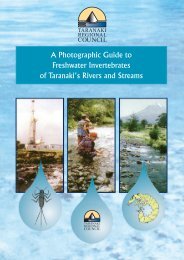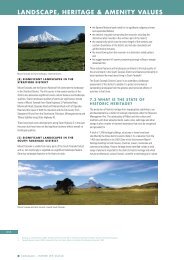Annual report 2006-2007 - Taranaki Regional Council
Annual report 2006-2007 - Taranaki Regional Council
Annual report 2006-2007 - Taranaki Regional Council
You also want an ePaper? Increase the reach of your titles
YUMPU automatically turns print PDFs into web optimized ePapers that Google loves.
3. <strong>Taranaki</strong> Galvanizers<br />
3.1 Process description<br />
38<br />
The galvanising plant of <strong>Taranaki</strong> Galvanizers is situated at the corner of State<br />
Highway 3 and Monmouth Road, about 1 km north of Stratford. The plant was<br />
owned and operated by Union Galvanizers 1995 Limited until September 1998, at<br />
which time that company ceased operating. The plant remained idle until May 1999,<br />
when <strong>Taranaki</strong> Galvanizers (2003) Ltd took it over. During the <strong>report</strong>ed period<br />
ownership changed once again, to <strong>Taranaki</strong> Galvanizers Limited.<br />
A hot-dip galvanising process is used. Under Union Galvanizers, operations<br />
consisted of stripping/degreasing steel articles in hot sodium hydroxide/water, a<br />
water rinse, a cold hydrochloric acid wash, a water rinse, pre-fluxing with zinc<br />
ammonium chloride, then hot-dipping in molten zinc. There is a separate galvanising<br />
stripping tank containing hydrochloric acid/water for articles that have previously<br />
been galvanised.<br />
The galvanising process employed by <strong>Taranaki</strong> Galvanizers is essentially the same as<br />
before. Minor changes have been made to improve product quality such as greater<br />
heating of the caustic degrease solution (with gas). Particular care is taken to ensure<br />
that flux solution dries on articles before they are dipped into the zinc kettle. This<br />
minimises fume generation and sputtering. In the 2003-2004 monitoring period the<br />
Company switched from the hosing of articles after caustic and acid treatment, to<br />
using a rinse tank. This resulted in a decrease in the volumes going to the trade<br />
waste tanks.<br />
Both dilute and strong liquid process wastes are produced. These are treated and<br />
disposed of separately. Dilute wastes from rinsing of articles in the galvanising<br />
process, condensation in steam-jacketed vessels, and floor washing are collected in a<br />
series of concrete tanks set within a concrete bunded area. The stormwater collected<br />
inside the bund is also pumped into the tanks. The tanks are used to pH neutralise<br />
and settle the wastewaters. The treated wastewater is then transported by road<br />
tanker from the galvanising plant to Stratford oxidation ponds after testing for zinc<br />
and pH under the supervision of the Stratford District <strong>Council</strong>.<br />
Site stormwater discharges to an unnamed tributary of the Kahouri Stream.<br />
Stormwater from the roof catchment is stored and utilised as process makeup, and is<br />
not discharged under the stormwater discharge permit unless this tank overflows.<br />
Strong wastes (comprising spent caustic cleaning and acid pickling liquors) are<br />
rarely stored on site. Plastic tanks situated in a bunded area lined with acid/caustic<br />
resistant resin are utilised entirely for emergency storage and have not been required<br />
for this purpose since 1995.<br />
The Kahouri Stream tributary originally began in the area where the galvanising site<br />
is situated and is now culverted from its origin to where it appears on the other side<br />
of SH3. The tributary downstream of the galvanising plant has been monitored<br />
regularly since it was discovered that spent acid containing a high concentration of<br />
zinc was disposed of in a bore on the galvanising plant site in mid-1987. Zinc leached<br />
through the ground and appeared in the drain, which runs under the galvanising














